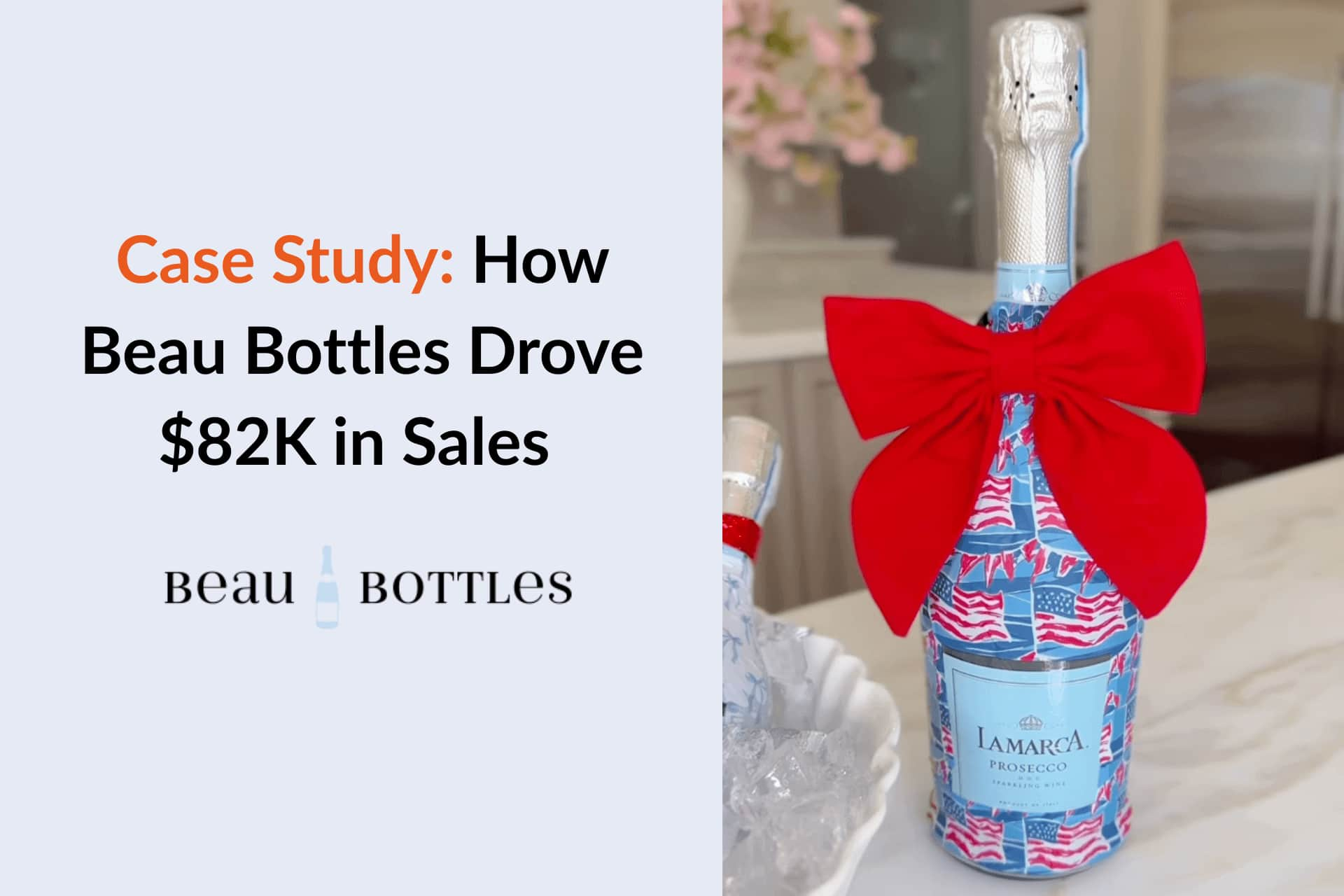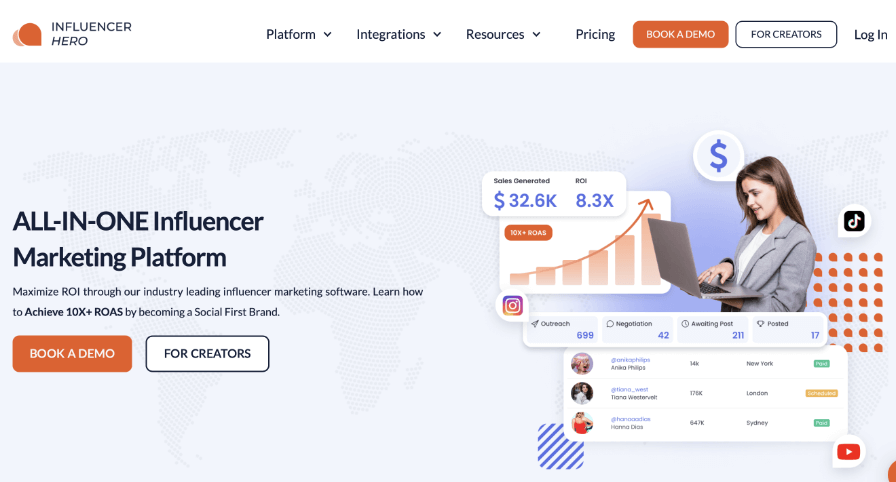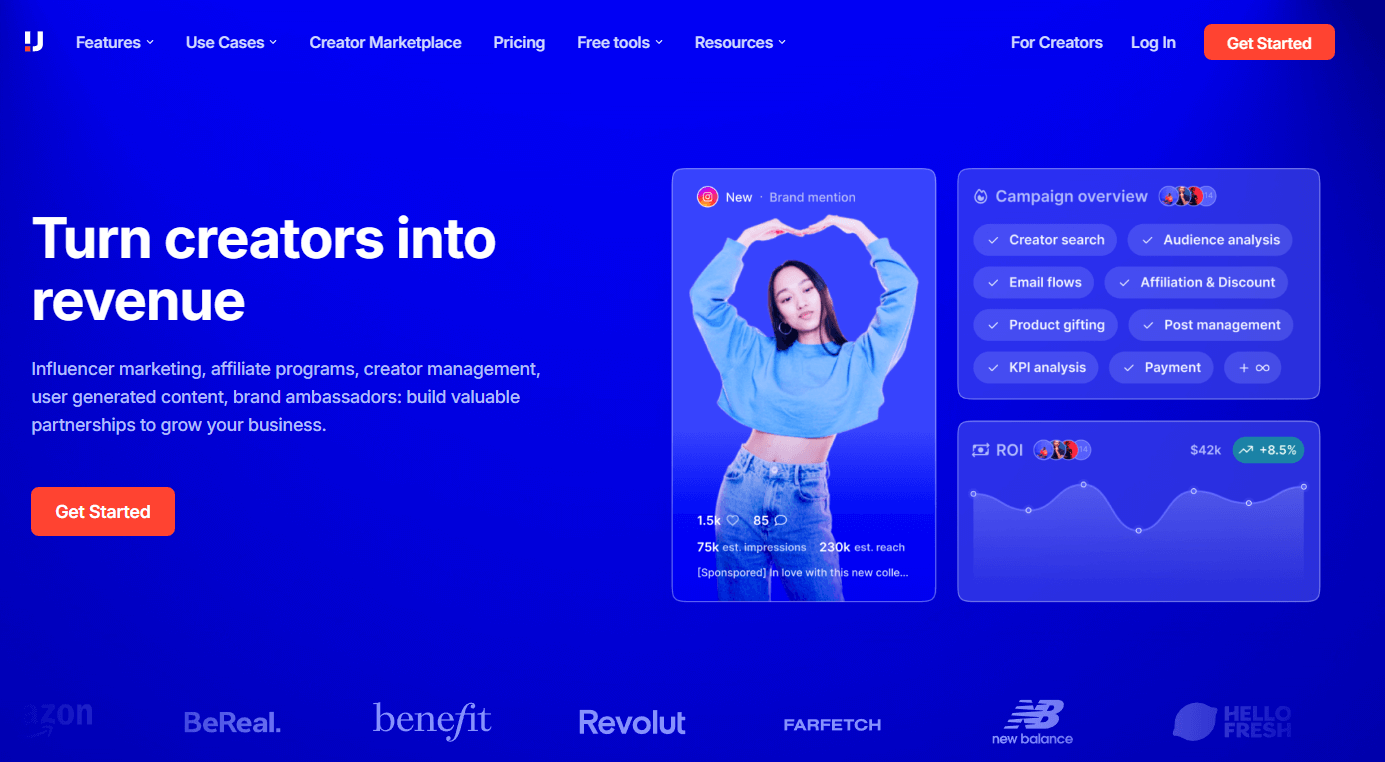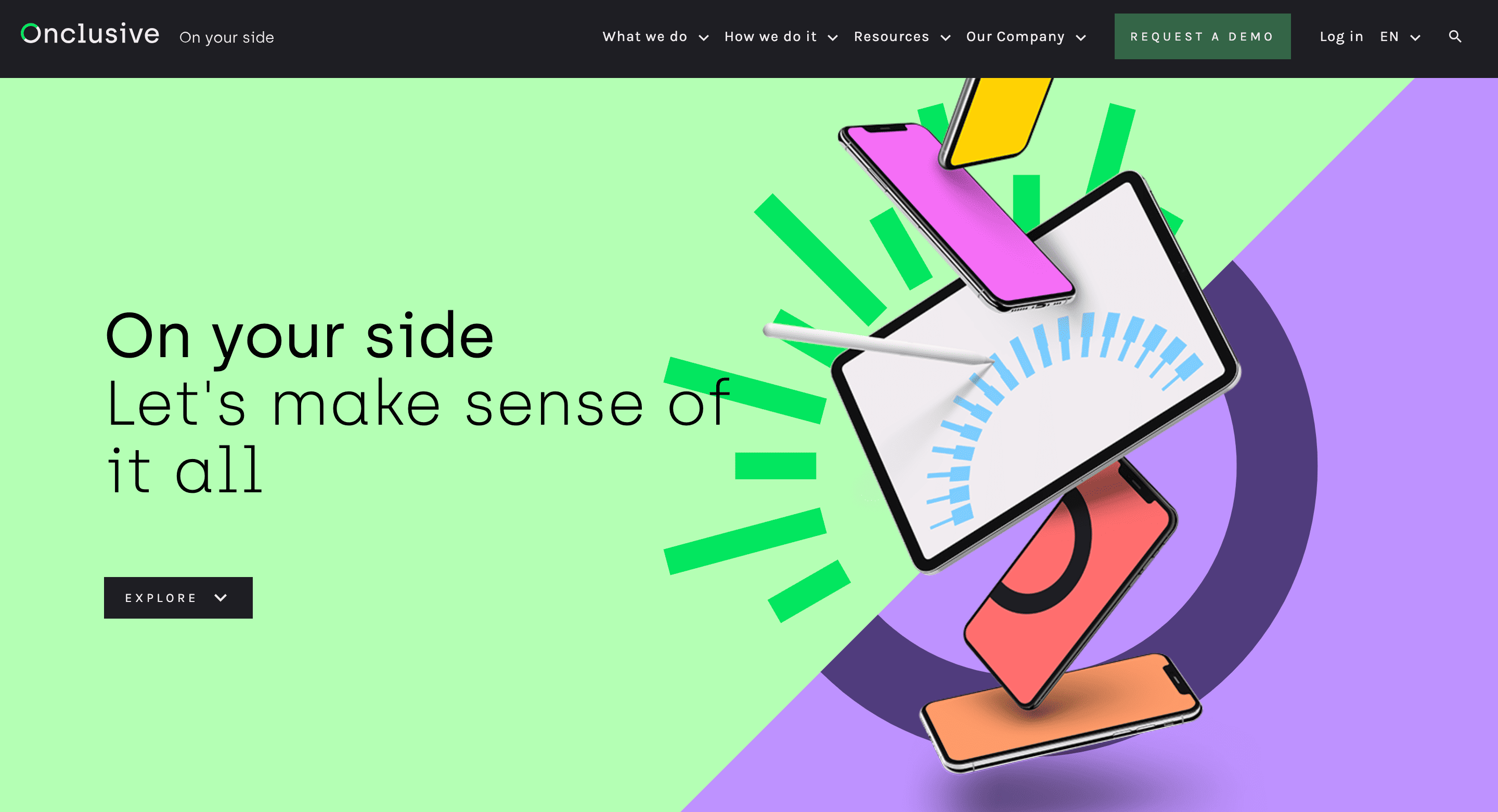





Wobb has become a go-to tool for many businesses looking to kickstart influencer campaigns. But as brands scale and campaigns become more complex, many marketers start running into the same issues: a limited creator database that makes it hard to run global campaigns, basic reporting features that don’t provide real performance insights, and a clunky interface that slows down workflows.
For D2C brands that rely on speed, clarity, and scale, these roadblocks can mean lost revenue and missed opportunities.
That’s where more robust Wobb alternatives come in—platforms built for growth-focused teams that want everything from discovery and outreach to tracking and affiliate management in one place.
With influencer marketing projected to hit $35 billion in global spending by the end of 2025 (source: Influencer Marketing Hub), choosing the right platform has never been more critical.
Below, we break down 10 of the best Wobb alternatives, comparing features, pricing, and user reviews to help you make the best choice for your brand:
While Wobb promotes itself as a global platform, many users report that the creator database lacks depth in key Western markets like the U.S., UK, and Australia. This makes it harder for brands targeting those regions to find high-performing, relevant influencers at scale. For global campaigns that require localized reach, this can limit growth.
Wobb provides basic analytics such as engagement rate and reach, but lacks more advanced reporting tools like sales attribution, conversion tracking, or cross-campaign performance comparisons. For marketers focused on ROI and data-driven decisions, this makes optimization and reporting harder than it needs to be.
Unlike platforms built for sales-focused influencer marketing, Wobb doesn’t offer built-in affiliate tracking or commission-based payout systems. As a result, teams running influencer affiliate campaigns often need to juggle external tools or manual spreadsheets to manage codes and payouts, which adds friction to the process.
Wobb’s campaign management tools are fairly limited in terms of automation. Bulk messaging, creator pipeline stages, and status updates often require manual input, slowing down campaign execution. Several users also note that the user interface can feel clunky and unintuitive, especially when managing multiple campaigns simultaneously.
Our comparison focuses on several key aspects:

Best For: Wobb is best suited for small to medium-sized eCommerce brands and agencies, particularly in emerging markets, looking for an end-to-end influencer marketing platform with managed service options.
Platform Coverage: Instagram, TikTok, and YouTube
Pricing: Wobb offers four pricing tiers:
Reviews: 4.8 / 5.0 (G2)
Ease of Use (UX/UI): Users generally find Wobb’s interface simple and easy to navigate for basic campaign tasks. However, some note that the setup process can be confusing at first, and the search feature may require improvement when filtering at scale. Regular software updates have helped improve the overall usability over time.
Customer Support: Wobb receives positive feedback for its responsive and multi-channel support, offering email, live chat, phone, FAQs, and a knowledge base. Users appreciate the guidance from dedicated account managers, especially when setting up their first campaigns.

Best For: Influencer Hero is best for growing D2C and eCommerce brands looking to scale influencer and affiliate campaigns through automation, data-driven insights, and multi-platform support. It’s particularly strong for teams running high-volume seeding, gifting, or affiliate programs that require detailed tracking and ROI measurement.
Platform Coverage: Influencer Hero supports campaigns across 8 major social platforms: Instagram, TikTok, YouTube, Facebook, Pinterest, Snapchat, X (Twitter), and Twitch.
Pricing: Influencer Hero offers flexible monthly plans:
Reviews: 5.0 / 5.0 (Capterra)
Ease of Use (UX/UI): The platform is known for its clean design and intuitive navigation, allowing teams to run campaigns with minimal onboarding. Users highlight the drag-and-drop workflows, AI-generated email templates, and visual dashboards as key features that streamline influencer operations.
Customer Support: Influencer Hero delivers top-tier support across all tiers: 24/7 real-human live chat, responsive email support, and a help center with video tutorials. Every plan includes a dedicated account manager, with Pro users also gaining access to a private Slack channel and optional strategy consultations.
While both Wobb and Influencer Hero are built to manage influencer campaigns end-to-end, they serve different types of teams. Wobb is best suited for small to mid-sized brands, particularly those focused on barter or local campaigns, while Influencer Hero is designed for growth-focused D2C and eCommerce brands looking to scale across multiple platforms with deep automation and ROI tracking.
A key difference lies in feature depth and pricing. Wobb’s pricing starts at $99/month but relies on a more basic model model, which can become expensive as outreach and campaign volume grow. Influencer Hero starts at $649/month, but includes AI-powered workflows, real-time reporting, affiliate tracking, and dedicated account support—delivering far more value for scaling teams.
Influencer Hero also supports 8 social platforms compared to Wobb’s 3, and includes powerful eCommerce integrations with Shopify and WooCommerce, making it the stronger long-term option for brands aiming to drive sales, not just awareness.

Platform Coverage: Modash supports influencer campaigns across Instagram, TikTok, and YouTube. While it can identify creator profiles on Snapchat and X (Twitter), core functionalities like outreach, analytics, and tracking are limited to the three main platforms.
Best For: Modash is ideal for eCommerce and D2C brands using Shopify who want to streamline influencer discovery, outreach, and affiliate management in one place. It's especially strong for teams running high-volume outreach with automated gifting and performance tracking.
Pricing: Modash offers three plans, billed annually:
Reviews: 4.6 / 5.0 rating (G2)
Ease of Use (UX/UI): Users frequently praise Modash’s streamlined and focused interface. The platform is known for being intuitive, with easy-to-navigate search filters, customizable campaign tracking, and an efficient workflow that doesn’t overwhelm users with unnecessary features.
Customer Support: Modash offers responsive live chat, onboarding sessions, and email support. Users appreciate the team’s transparency and personalized guidance, especially during onboarding and strategy alignment. Support documentation is clear, and their team is quick to follow up during trials or plan upgrades.
Wobb and Modash both offer influencer discovery and campaign management features, but their focus and strengths differ significantly. Wobb appeals to small and mid-sized brands looking for a simple, cost-effective way to launch influencer campaigns—its entry price of $99/month makes it accessible, but its limited global reach and analytics can become constraints as campaigns scale.
Modash, on the other hand, offers a more advanced toolkit geared toward performance marketers, especially those on Shopify. At $199/month (Essentials) and $499/month (Performance), Modash delivers powerful discovery tools, real-time tracking, AI-assisted search, and robust affiliate automation features. However, it may not be suitable for brands using non-Shopify platforms.
For D2C brands that prioritize data, scale, and automation—especially around affiliate performance—Modash offers more power under the hood. But for budget-conscious teams with simpler needs, Wobb remains a solid entry-level option.

Best For: Upfluence is best for mid-size to enterprise eCommerce brands, particularly those selling on Shopify or Amazon, that want an all-in-one solution for influencer discovery, campaign execution, affiliate tracking, and payouts.
Platform Coverage: Upfluence supports influencer campaigns across Instagram, TikTok, YouTube, X (Twitter), Twitch, Pinterest, and WordPress blogs, offering multi-platform discovery, tracking, and campaign management.
Pricing: Upfluence offers annual contracts with a monthly breakdown:
Reviews: 4.3 / 5.0 (Capterra)
Ease of Use (UX/UI): While robust, Upfluence can come with a learning curve for new users. The dashboard offers extensive capabilities, but onboarding support is often needed to take full advantage of its features.
Customer Support: Users highlight responsive email and chat support, along with guided onboarding. While helpful, some note the platform could benefit from more real-time support and flexible onboarding resources for smaller teams.
While Wobb offers an affordable entry point into influencer marketing, it lacks the deep integrations, real-time tracking, and enterprise features that Upfluence brings to the table. Wobb is a better fit for small teams prioritizing budget over breadth, while Upfluence is built for eCommerce brands serious about ROI.
In terms of pricing, Wobb starts at $99/month, while Upfluence begins at $1,276/month with no monthly cancellation options, making it a significant investment. However, Upfluence includes Amazon and Shopify integrations, affiliate link tracking, secure payouts, and social listening—features that Wobb does not offer.
For larger teams ready to scale and automate every part of their influencer program, Upfluence provides unmatched depth and eCommerce alignment.

Best For: Captiv8 is best suited for enterprise-level brands and agencies running high-budget, multi-channel influencer campaigns with in-depth analytics, competitive tracking, and internal team collaboration needs.
Platform Coverage: Captiv8 supports influencer campaigns across Instagram, TikTok, YouTube, X (Twitter), Pinterest, Facebook, and Twitch. It also offers performance tracking and brand mention monitoring across social platforms.
Pricing: Captiv8 requires a $25,000 annual contract (no monthly billing), plus a $3,000 one-time onboarding fee. To access Storefronts and Affiliate tools, an additional $20,000–$30,000 per month is required. There are no flexible plans for smaller brands or trials.
Reviews: 4.4 / 5.0 (G2)
Ease of Use (UX/UI): Captiv8’s platform is considered powerful but somewhat complex, especially for new users. However, teams managing multiple campaigns benefit from the collaborative dashboard and customizable report builder.
Customer Support: Customer service reviews are mixed. While some enterprise users report helpful onboarding, others - especially smaller brands and creators - note delayed responses and unresolved payment issues.
Wobb positions itself as a lightweight, budget-friendly influencer management tool, while Captiv8 is clearly built for enterprise brands with deep budgets and high campaign complexity. Wobb offers core functionalities like influencer outreach and campaign tracking at $99/month, making it accessible to startups and DTC brands.
On the other hand, Captiv8 requires a $25K/year commitment, not including the optional $20–30K/month for storefront and affiliate tools. While Captiv8 offers far more advanced reporting, collaboration, and discovery filters, it also comes with a steep price tag and limited support flexibility.
For lean teams or brands new to influencer marketing, Wobb may offer a faster, simpler starting point, whereas Captiv8 is a better fit for companies ready to scale globally with complex internal workflows and deep analytics needs.

Platform Coverage: CreatorIQ supports influencer marketing across Instagram, TikTok, YouTube, Facebook, Pinterest, Twitch, and X (Twitter). The platform offers global data coverage with direct API access to major social platforms (excluding some Chinese regions).
Best For: CreatorIQ is ideal for enterprise brands and agencies managing complex, large-scale influencer programs who need deep integrations, high data reliability, and dedicated strategic support.
Pricing: CreatorIQ offers annual contracts only, with pricing as follows:
Add-on: “Creator Connect” application page for $15,000/year. Creator payments are included with a 2% fee after $100K in transactions/year.
Reviews: 4.6 / 5.0 (G2)
Ease of Use (UX/UI): While CreatorIQ is extremely comprehensive, its advanced features require time to master. Enterprise teams report it as efficient once set up, but smaller teams may find the UI overwhelming at first.
Customer Support: The platform is known for strong, hands-on customer support. Each account receives a dedicated implementation and customer success manager, along with quarterly strategic reviews and onboarding support.
Wobb is built for simplicity and affordability, appealing to small- and mid-sized brands that need a basic, accessible influencer marketing platform. It offers key functionalities like creator discovery, content approval, and campaign tracking starting at just $99/month—ideal for brands working with limited resources or just beginning to scale.
In contrast, CreatorIQ caters to global enterprises, offering unmatched data accuracy, API-level integrations, and full lifecycle campaign management, but starting at $35,000/year.
While Wobb is faster to adopt, CreatorIQ offers a more powerful infrastructure for teams managing hundreds of creators or requiring advanced reporting, automation, and financial compliance. Ultimately, the decision comes down to scale, budget, and team resources.

Best For: Ideal for brands, agencies, and eCommerce businesses focused on performance-driven influencer marketing with a strong need for audience authenticity and fraud detection.
Platform Coverage: HypeAuditor supports Instagram, TikTok, YouTube, X (Twitter), Twitch, and Snapchat—covering all major social platforms for influencer marketing.
Pricing: HypeAuditor offers customizable pricing based on usage. The standard “Business” plan starts at around $10,000/year with 2,000 reports included. Enterprise plans are quoted at $60,000/year with unlimited usage. A 24h or 48h free trial is available for new users.
Reviews: 4.8 / 5.0 (Capterra)
Ease of Use (UX/UI): Users appreciate HypeAuditor’s robust data visualization and filtering tools but note that the platform has a steeper learning curve. The dashboard provides a lot of metrics at once, which may require a few sessions to fully understand and navigate.
Customer Support: Support is responsive and available through email and ticket-based systems. However, some users mention that onboarding is essential due to the depth of features, and live chat is not always instantly available.
Wobb and HypeAuditor cater to different ends of the influencer marketing spectrum. Wobb is more focused on influencer discovery, UGC sourcing, and campaign gifting, often catering to small-to-medium-sized brands with limited budgets.
In contrast, HypeAuditor positions itself as an analytics-first platform with highly detailed influencer reports, AI-powered discovery, and fraud detection - features especially valued by data-driven teams and enterprise agencies.
In terms of pricing, Wobb is significantly more affordable and even offers a free plan, whereas HypeAuditor starts at around $10,000 per year. However, the difference in cost comes with a difference in capability - HypeAuditor provides far deeper analytics, more advanced search, and stronger fraud protection.
Brands seeking a more robust verification and reporting engine will likely lean toward HypeAuditor, while budget-conscious teams with simpler needs may stick with Wobb.

Platform Coverage: GRIN supports influencer marketing on Instagram, TikTok, YouTube, Facebook, and Pinterest, with direct integrations for eCommerce platforms like Shopify, WooCommerce, and Magento.
Best For: GRIN is built specifically for DTC eCommerce brands that want to manage end-to-end influencer marketing workflows—from discovery and outreach to shipping, tracking, and payments—in a single platform.
Pricing: Pricing starts at around $25,000 per year, with higher-tier packages costing up to $100,000+ annually depending on the number of users and integrations. All plans require an annual contract, with no free trial.
Reviews: 4.5 / 5.0 (G2)
Ease of Use (UX/UI): Users highlight that GRIN has an intuitive, clean interface that makes campaign creation and creator management feel seamless. However, some note a learning curve in onboarding due to the wide breadth of features available.
Customer Support: GRIN offers dedicated onboarding and support, including customer success managers for each account. Most users are satisfied with the support but mention that some advanced questions or issues may take longer to resolve due to response time variability.
Wobb is a simpler and much more affordable influencer marketing solution that works well for small to mid-sized brands focusing on creator discovery, gifting, and basic campaign tracking. Plans start at just $99/month, with options to scale depending on usage.
On the other hand, GRIN is a powerhouse tailored to scaling DTC brands, especially those using Shopify. It provides far more robust tools for end-to-end influencer workflows, eCommerce integrations, affiliate tracking, and content rights management.
However, the price point—starting around $25,000/year—makes it best suited for brands with a sizable influencer budget and a dedicated team to manage execution. Wobb wins on affordability and ease of entry, while GRIN shines in feature depth and infrastructure for long-term growth.
Discover: Top 10 Grin Alternatives of 2025

Best For: Saral is ideal for DTC brands using Shopify looking to run influencer gifting and affiliate campaigns at scale. Its automation tools and real-time search engine make it a strong choice for lean marketing teams that want to move fast without sacrificing control.
Platform Coverage: Saral supports influencer discovery and tracking across Instagram, TikTok, and YouTube. It operates as a real-time search engine—there’s no influencer opt-in or marketplace, meaning brands get access to a broad spectrum of public profiles instantly.
Pricing: Saral offers three main plans:
Reviews: 4.7 / 5.0 (G2)
Ease of Use (UX/UI): Saral’s interface is streamlined for startup and growth-stage DTC teams, with quick onboarding and an intuitive email and gifting flow. Users mention it’s easy to navigate, especially compared to larger platforms with steeper learning curves.
Customer Support: Support is responsive and includes personalized onboarding. Users say the team is highly attentive and quick to act on feedback, which is appreciated especially during campaign launches or when troubleshooting integrations.
While both Wobb and Saral offer influencer discovery, Saral takes a more automation-first approach tailored for DTC brands - especially those on Shopify. Wobb operates with more CRM-heavy features and project workflows, but Saral’s real-time search engine and Shopify-native gifting tools streamline creator outreach, gifting, and affiliate tracking in one platform.
On pricing, Wobb’s plans start at approximately $249/month, significantly lower than Saral’s $3,600/quarter entry point. However, Saral compensates with a deeper feature set for automation and ecommerce-centric campaigns.
If you're a Shopify-based brand looking for speed, scale, and minimal manual work, Saral may be the better long-term investment.

Best For: Onclusive is best suited for enterprise brands and PR teams looking to combine influencer monitoring with robust media intelligence and earned media tracking. It’s especially useful for companies needing cross-channel sentiment analysis, competitive benchmarking, and real-time news/social tracking.
Platform Coverage: Instagram, TikTok, YouTube, Twitter/X, Reddit, Facebook, LinkedIn, Threads, BlueSky, WeChat, and Weibo.
Pricing: Onclusive pricing ranges from $8,000–$20,000 annually, depending on the scope and media types included. The tool is typically billed annually, but custom billing schedules may be arranged.
Reviews: 4.4 / 5.0 (G2)
Ease of Use (UX/UI): Users describe Onclusive’s interface as professional and data-rich, though the depth of functionality can result in a learning curve. The platform excels in creating automated dashboards and reports, but setup and customization may require some initial training.
Customer Support: Onclusive provides a dedicated account manager for each client, assisting with onboarding, search query setup, and platform training. Customers appreciate the responsive support team and the flexibility to modify search parameters anytime.
Wobb and Onclusive serve different ends of the influencer marketing spectrum.
Wobb is geared more toward influencer discovery and outreach automation, making it a better fit for DTC brands and eCommerce teams looking to scale micro-influencer campaigns efficiently. In contrast, Onclusive is better suited for enterprise-level media monitoring, offering tools for sentiment tracking, press mentions, and traditional media analytics.
Pricing is another key differentiator. While Wobb offers a more flexible pricing model for smaller teams and startups, Onclusive’s plans start at around $8,000/year, making it more ideal for established brands with larger budgets and in-house PR needs.
If your focus is comprehensive brand monitoring and competitive intelligence rather than creator management, Onclusive might be the right fit.

Best For: Best suited for brands looking to tap into the Gen-Z demographic through NCAA and college athlete influencers. MOGL is ideal for businesses targeting performance-based partnerships, especially in the wellness, lifestyle, and sports categories.
Platform Coverage: Instagram (primary focus) and TikTok.
Pricing: MOGL offers custom pricing based on the size and scope of your campaign.
Reviews: 4.5 / 5.0 (G2)
Ease of Use (UX/UI): Users describe the platform as modern and easy to navigate, with intuitive features for campaign setup and talent discovery. The self-serve dashboard is clean and optimized for brands who want fast access to athlete creators.
Customer Support: MOGL offers hands-on campaign support for brands, especially for those leveraging their white-glove service. Clients highlight responsive onboarding teams and access to athlete partnerships staff that help streamline deals and contracts.
While Wobb aims to serve a broad range of brands with influencer discovery, campaign tracking, and analytics tools, MOGL stands out for its niche focus on Gen-Z student-athletes and its emphasis on NCAA compliance. Wobb is a generalist platform with affordability and scalability, whereas MOGL is more of a specialist—particularly effective if your product aligns with sports, youth, or education-based audiences.
From a pricing standpoint, Wobb offers clearer plan structures starting from $299/month, while MOGL’s pricing is custom and campaign-dependent, which may work best for brands seeking more personalized or full-service execution.
If you’re looking for a self-serve SaaS model with broader creator categories, Wobb is the better fit. But if Gen-Z athletes are your target and you want access to a curated, NCAA-compliant marketplace, MOGL delivers a focused advantage.
Choosing the right influencer marketing platform depends on your brand’s size, goals, and preferred workflow.
While Wobb is a strong contender for brands seeking a straightforward and affordable solution, it may not meet every brand’s need for scale, advanced analytics, or influencer diversity. Platforms like Influencer Hero, Upfluence, CreatorIQ, and Captiv8 provide more robust discovery tools, AI-powered campaign automation, and deeper integration with eCommerce or CRM systems.
Among all the alternatives, Influencer Hero stands out as one of the most comprehensive and scalable solutions. Whether you’re just starting out or scaling globally, Influencer Hero offers the features and support to take your influencer marketing to the next level. Curious to see how it aligns with your brand’s goals? Book a free demo and let’s explore it together.

Wobb is a solid entry-level tool, but many users look for alternatives due to limitations in analytics, influencer diversity, and automation features. If you need more advanced campaign tracking, deeper audience insights, or cross-platform capabilities, exploring options like Influencer Hero, Modash, or Upfluence can offer more scalability and customization.
Influencer Hero is considered one of the best alternatives for eCommerce brands, especially those on Shopify. It offers features like affiliate tracking, gifting automation, and a robust creator database—making it ideal for brands looking to scale influencer and affiliate campaigns efficiently.
Wobb is great for budget-conscious startups, but it lacks some of the automation and real-time reporting features larger brands may require. Influencer Hero, on the other hand, offers AI-powered creator discovery, automated outreach, cross-platform analytics, and dedicated account support, making it more suitable for growth-focused teams.
While most robust platforms are paid, some like Saral offer lightweight tools or outreach-focused plans at lower price points. However, for brands looking for better ROI and automation without compromising quality, Influencer Hero offers flexible pricing tiers to match different needs and budgets.
Many platforms offer decent support, but Influencer Hero stands out for its 24/7 live chat, dedicated account managers for all plans, and access to private Slack channels for Pro users. This level of hands-on support is often cited as a key reason brands switch from Wobb.



Schedule a Demo with one of our media experts below.